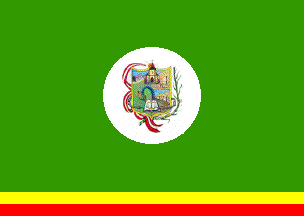
image by Ivan Sache, 22 March 2015

Last modified: 2021-08-25 by rob raeside
Keywords: trujillo | laredo | la libertad | peru |
Links: FOTW homepage |
search |
disclaimer and copyright |
write us |
mirrors

image by Ivan Sache, 22 March 2015
The district municipality of Laredo (33,635 inhabitants in 2007;
33,544 ha) is located in the Santa Catalina valley, in the south-east
of the Trujillo Province, east of the town of Trujillo. The
municipality is made of the town of Laredo and of the rural
settlements of La Merced, Barraza, Santo Domingo, Galindo, San Carlos,
Cerro Blanco, Quirihuac, Bello Horizonte, Santa Rosa, Las Cocas, Jésus
María, Menocucho and Conache.
Laredo was established in a place known in the 16th century as "the
land and mill of Ines de Ayala". The place was renamed in the 18th
century San Nicolás del Paso, the mill being placed under the
protection of St. Nicholas of Tolentino (c. 1245-1305; canonized on 5
June 1446 by Pope Eugene IV).
Gaspar Antonio Remírez y Laredo, Mayor of Trujillo, acquired the San
Nicolás estate in the beginning of the 19th century. He was allowed on
14 August 1813 by the Royal authorities to plant sugarcane on his
estate and to develop sugar production, which was manned by slavery.
This emerging industry boosted the development of a settlement, named
Laredo for the owner of the estate. Established on 9 December 1878,
the original settlement was made of the boroughs of Laredo and La
Merced.
The Laredo district was established by Law no. 13,792 of 28 December
1961. Laredo was granted the title of "ciudad" by Law No. 25,253 of 19
June 1990.
Source: http://www.munilaredo.gob.pe/ - Municipal website
Ivan Sache, 22 March 2015
The symbols of Laredo are prescribed by Resolution No. 3 of 19 June
1990. The symbols were presented on 9 December 1978 by the Committee
of the First Centenary of the Villages of Laredo and La Merced,
presided by Roberto Meza.
The flag, designed by Marco Antonio Malabrigo Clara Meza Finochetti,
is horizontally divided (prescribed, 8:1:1; in the cloth, 8:0.5:0.5)
light green-yellow-vermillion (bright) red. In the middle of the green
stripe is placed a green disk "of 10 thumb in diameter" [charged with
the municipal coat of arms].
Green is a symbol of aspiration to a prosperous future based on
production and services.
Yellow is a symbol of the immense force and power of the spiritual
resources and their material manifestations.Red is a symbol of the incommensurable love and heroism of the
inhabitants who offered their life for the defence of freedom,
democracy and human rights.
White is a symbol of the nobleness of the spiritual resources of the
inhabitants.
The coat of arms of Laredo is bordered by a yellow outline symbolizing
the resources of the local land. It was designed to represent the pre-Hispanic past, the Republican present, and the future of the
municipality.
The shield is surmounted by an orange rising sun. The upper part of
the shield features in the middle the church dedicated to Jesus and
Mary, symbolizing the Catholic faith shared by 90% of the inhabitants
of the town. The mountain peak on the left symbolizes the demographic
rising of Laredo. The church is flanked on the right by two terracotta
vases belonging to the Eupisnique culture, excavated from the Dacha de
los Reyes in the archeological site of Caballo Muerto (Galindo).In the middle of the shield, a blue cog wheel with steel blue cogs
represents industry, while a maize cob represents the independent
smallholders. The open book represents education and culture; it is
charged with a pair of scales representing the proper balance of
social justice. The lower right quarter features a terracotta frieze
featuring human beings and wild felines.
The shield is wrapped in base by a gray chain, representing the human
rights and integral freedom.
The shield is supported dexter by a red-white-red scroll representing
the republic and sinister by a sugarcane, the main crop in the district.
Sources: http://www.munilaredo.gob.pe/pag_sim.php
- Municipal website
http://laredoperu.blogspot.fr/2008/10/los-simbolos-de-laredo.html
-
Laredo blog
Ivan Sache, 22 March 2015